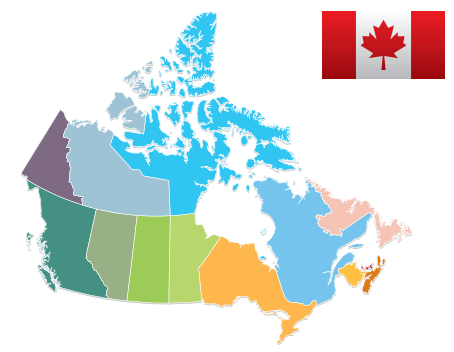
Canada overview
 A product of the Energy Mines Ministers’ Conference
A product of the Energy Mines Ministers’ Conference
| Installed Capacity | 140 GW |
| Annual Generation | 639 TWh |
| Annual Consumption | 550 TWh |
| Annual Exports Footnote 1 | 68.4 TWh |
| Annual Imports Footnote 1 | 8.7 TWh |
| Major Transmission Connections with the United States | 34 (≥ 100 kV) |
| Major Interprovincial Connections | 33 (≥ 69 kV) |
Generation mix in Canada (2014)Footnote 2
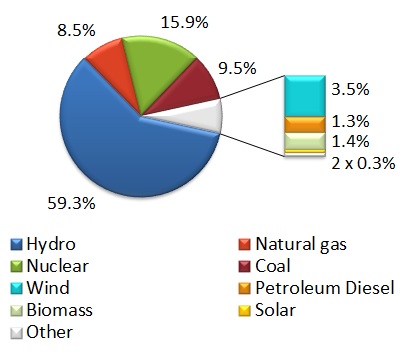
Text version of Pie Chart
Pie Chart of Canada’s electricity generation mix (2014): hydro 59.3%, nuclear 15.9%, coal 9.5%, natural gas 8.5%, wind 3.5%, and others less than 2%.
Canada’s electricity supply generation mix varies significantly among Canada’s provinces and territories (see links above). Canada’s future Energy Supply and Demand Projections are reported by the Canada Energy Regulator.
Key federal organizations
The Canada Energy Regulator (CER, formerly the National Energy Board) is Canada’s energy and safety regulator and it operates under a variety of acts and regulations. It has jurisdiction over the construction, operation and abandonment of international power lines (IPL), between Canada and the United States, and designated interprovincial power lines. The CER accepts standards adopted or approved by a provincial authority or a standards development authority as defined under the General Order MO-036-2012 and Amending Orders on electricity reliability.
Natural Resources Canada (NRCan) is the lead federal department responsible for monitoring, assessing and providing advice and guidance to the Governor in Council, as well as other government stakeholders on any energy related emergencies. The Minister of Natural Resources has a mandate to protect Canada’s energy security; encourage energy efficiency and conservation; and bring cleaner, renewable energy onto a smarter electricity grid.
Electricity reliability frameworks in Canada
In Canada, regulatory oversight of electric reliability rests primarily within the jurisdiction of the provinces and territories. Links to each jurisdiction are provided at the top of the page. Federal jurisdiction is limited to the permitting of international exports and the construction and operation of international power lines and designated interprovincial power lines by the CER.
The reliability of the bulk electric system is based on its ability to continuously balance electricity supply and demand in real time.
Canada, Mexico and the United States share a highly integrated electrical transmission network which is referred to as the North American Bulk Electric System (BES).
As described in the report After the Blackout: Implementation of Mandatory Electric Reliability Standards in Canada, in response to the 2003 North American blackout, Canada and the United States have worked together to harmonize the implementation of mandatory reliability standards as developed by a single Electric Reliability Organization (ERO). Over 100 standards have been developed which cover all aspects of reliability including: transmission operations, resources and demand balancing, facility design and maintenance, system planning, communications, training, cyber and physical security, and emergency preparedness.
The North American Electric Reliability Corporation (NERC) was certified as the ERO for the United States in 2006. In Canada, recognition of NERC and its regional entities as the ERO, adoption of NERC Reliability Standards, and the establishment of measures to monitor and enforce the standards are done at the provincial level. Each Canadian jurisdiction with mandatory reliability standards has put in place processes to consider the adoption or modification of NERC standards. The standards are mandatory and enforceable, or are in the process of becoming mandatory and enforceable in almost all provinces connected to the BES.
Provinces and territories
Yukon
| Installed CapacityFootnote 3 | 148.1 MW |
| Annual GenerationFootnote 4 | 417 GWh |
| Annual Consumption | NA |
| Customers | ~ 21,000 |
| Annual Exports | 0 GWh |
| Annual Imports | 0 GWh |
| Transmission System length (≥66 kV) | ~ 957 km |
| Interconnections | none |
Installed capacity mix (2014)Footnote 5
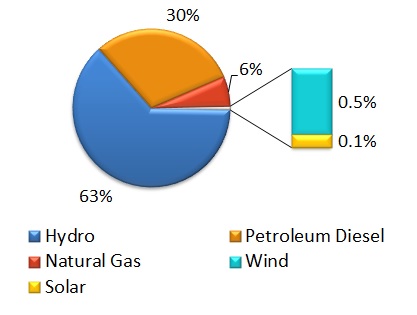
Text version of Pie Chart
Pie Chart showing Yukon’s installed capacity mix (2014): hydro 63%, petroleum diesel 30%, natural gas 6%, and others less than 1%
The transmission and distribution of electricity in Yukon occurs over 6 isolated grids. The Energy Strategy for Yukon supports a shift towards cleaner, renewable sources of energy for the territory
Key organizations
The Government of Yukon (YG) provides strategic direction, policy and monitoring services to Yukon’s electricity sector. YG is also responsible for the bulk of energy efficiency programs in the territory.
The Yukon Utilities Board (YUB) is a Regulatory Board that consists of three to five members, one of which is the Chair and one of which is the Vice-Chair. Members are appointed by the Government of Yukon.
The Yukon Development Corporation (YDC) is a Crown corporation of the Government of Yukon and the parent company to the Yukon Energy Corporation. YDC is currently acting as Yukon large energy infrastructure planner, and is evaluating the feasibility and financing of the Stewart/Keno Transmission Line and Yukon’s Next Generation Hydro Project.
The Yukon Energy Corporation (YEC) is a Crown corporation that operates as a utility, at arms-length from the Yukon government. YEC is the main generator and transmitter of electrical energy in Yukon.
ATCO Electric Yukon is a privately owned company of the ATCO Corporation in Alberta. It is a recognized distributer of electricity in the territory; purchasing power from Yukon Energy Corporation for distribution to its customers. ATCO is also a limited generator of electricity, owning 1.3MW installed hydro capacity, and 14.6MW of installed diesel capacity. ATCO is responsible for providing electricity to Yukon’s four remote communities.
Electric reliability framework in Yukon
Yukon’s transmission and distribution system is made up of six isolated power grids: the bulk of Yukon’s electricity is generated for and distributed to the Yukon Integrated System, while the remaining five systems - Old Crow community diesel, Beaver Creek community diesel, Burwash Landing/Destruction Bay community diesel, Swift River community diesel, and Watson Lake community diesel - service smaller areas. All systems are independent of the North American Bulk Electric System.
Yukon’s utilities are regulated by the Yukon Utilities Board (YUB). The YUB’s mandate, in summary, includes:
- issuing orders fixing rates of a public utility;
- prohibiting or limiting any proposed rate change;
- fixing proper and adequate rates and methods of depreciation, amortization or depletion in respect of the property of any public utility;
- fixing standards, classifications, regulations, practices, measurements or services to be observed, provided or followed by a public utility, and
- determining areas that services of a public utility shall provide.
Under the Yukon Public Utilities Act it is the responsibility the Yukon Utilities Board to regulate franchised utilities that generate, transmit and distribute power in the territory. Yukon currently (2016) has two franchised utilities, the publically-owned crown corporation Yukon Energy Corporation, and the privately-owned ATCO Electric Yukon. Both utilities are required to maintain sufficient spinning reserve to compensate for the loss of the largest generating unit during the system peak. This means that any of Yukon’s isolated grids can have more twice the generating capacity installed than what is required to meet peak winter load to ensure reliability. In practice, approximately 95 per cent of electricity generated in Yukon annually is produced from renewable resources such as hydro.
Yukon’s energy planning is comprised of three main documents:
- The Energy Strategy for Yukon;
- The 2016 Integrated Resource Plan (in process); and
- The Next Generation Hydro Project (in process).
Northwest Territories
| Installed CapacityFootnote 6 | 269 MW |
| Annual GenerationFootnote 7 | 624 GWh |
| Annual Consumption | 624 GWh |
| Customers | ~ 12,000 |
| Annual Exports | 0 GWh |
| Annual Imports | 0 GWh |
| Transmission System length* | ~ 420 km |
| Interconnections | None |
Installed capacity mix (2015)Footnote 8
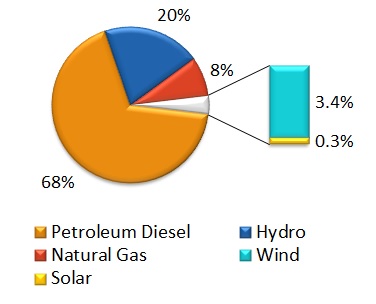
Text version of Pie Chart
Pie Chart showing Northwest Territories’ installed capacity mix (2015): diesel 68%, hydro 20%, natural gas 8%, and others less than 4%
*The Northwest Territories has two isolated transmission systems – to service the North and South Slave regions – totalling 420 km
Key organizations
The Northwest Territories Public Utilities Board (PUB) is an independent, quasi-judicial agency of the Government of the Northwest Territories. It is responsible for the regulation of public utilities in the NWT. The PUB obtains its authority from the Public Utilities Act.
The Northwest Territories Power Corporation (NTPC) is a Crown Corporation and public utility 100% owned by the Government of the NWT. NTPC generates most of the power in the NWT and is responsible for transmission. It owns and operates three hydro facilities and is responsible for generation, distribution and sale of electricity in most of the NWT’s isolated and remote communities.
Northland Utilities (NUL) is an investor owned electricity utility. NUL buys wholesale power from NTPC, distributes and sells that power in Yellowknife, Hay River and surrounding communities. NUL also generates, distributes and sells power in four isolated communities in the NWT.
Electric reliability framework in Northwest Territories
The Northwest Territories is not connected to the North American Bulk Electric System and does not apply North American Electric Reliability Corporation (NERC) reliability standards.
Under the Northwest Territories Power Corporation Act it is the responsibility of the NTPC to generate, transmit and distribute power in the territory “on a safe, economic, efficient and reliable basis.” The NTPC is regulated by the Public Utilities Board of the NWT and is required to file information on reliability performance, specifically on customer outage information. In remote communities, a reserve margin of 5-10 percent is required to account for normal demand variations. Additionally, a reserve margin large enough to compensate for the loss of the largest generating unit during the system peak, must be available. In practice this means that a community can have more than twice the generating capacity installed than what is required to meet peak winter load to ensure reliability.
Nunavut
| Installed Capacity | 75.5 MW |
| Annual Generation | 184 GWh |
| Annual Consumption | 183 GWh |
| Customers | ~ 14,400 |
| Annual Exports | 0 GWh |
| Annual Imports | 0 GWh |
| Transmission System length (≤ 25 kV) | ~ 346 km |
| Interconnections | None |
Installed capacity mix (2015)Footnote 9
.jpg)
Text version of Pie Chart
Pie Chart showing Nunavut’s installed capacity mix (2015): diesel 100%
While all of Nunavut’s power supply is produced by diesel generator, the Quilliq Energy Corporation is in the process of testing a solar array at the Iqaluit Main Plant facility and conducting a wind energy feasibility study.
Key organizations
The Qulliq Energy Corporation (QEC) is a Territorial Corporation wholly owned by the Government of Nunavut (GN). QEC is incorporated and operates under the Qulliq Energy Corporation Act and its energy pricing is regulated pursuant to the Utility Rates Review Council Act. QEC attends to the overall objectives provided by legislation, supports the Minister responsible for Qulliq Energy Corporation on intergovernmental and regulatory issues, has the mandate to manage the capital projects of the Corporation, and develop alternative generation sources.
Electric reliability framework in Nunavut
Nunavut is not connected to the North American Bulk Electric System and does not apply NERC (North American Electric Reliability Corporation) standards. The Qulliq Energy Corporation Act mandates QEC “to generate, transform, transmit, distribute, deliver, sell and supply energy on a safe, economic, efficient and reliable basis” and “to plan and provide for Nunavut's long term needs for affordable energy, taking into consideration Nunavut's desire to enhance energy self-reliance and to conserve energy and energy resources”. QEC is also designated by the Qulliq Energy Corporation Act as the sole retail supplier of power in Nunavut.
QEC generates and delivers electricity to approximately 14,400 customers in 25 communities across Nunavut. All electricity needs in Nunavut are met by imported fossil fuel supplies, and each community has its own independent electricity generation and distribution system. There is no back-up grid. QEC is the only energy corporation in Canada without developed local energy resources or regional electricity transmission capability, creating a situation of high dependency on fossil fuel.
Reliability is one of the Corporation’s top priorities. During the 2014-2015 fiscal year, QEC maintained power supply to all customers on average 99.85 percent of the time surpassing the previous year’s reliability rate of 99.74 percent. QEC calculates its reliability on the number of planned and unplanned outages that occur during the year, and the length of time that customers are without power. Planned outages are necessary when work is needed on power plant or distribution systems and to ensure the safety of Operations & Maintenance technicians. Unplanned outages generally occur due to extreme weather, outside influences or unexpected failures.
- QEC averages fifth most reliable out of 8 Canadian utility corporations based on data from the last 6 years according to the Canadian Off-Grid Utilities Association (COGUA).
- Reasonable notice of any scheduled outages is provided to customers whenever possible. Such interruptions are as short and infrequent as circumstances permit.
- Unscheduled, unforeseen outages are tended to as quickly and safely as possible.
Improvements in reliability are an ongoing focus, as are improved operational and maintenance practices, including such measures as pro-active inspections of plants and equipment. Priority is also being placed on future distribution capital projects including:
- updating primary conductors and transformer substations;
- reallocating loads to balance feeder and phase currents within the distribution system; and
- resolving cold load pick up issues.
British Columbia
| Installed Capacity | 17,475 MW |
| Annual Generation | 63,648 GWh |
| Annual Consumption | NA |
| Customers | ~ 2.1 million |
| Annual Exports | 9,661 GWh |
| Annual Imports | 9,751 GWh |
| Transmission System length (≥ 69 kV) | ~ 20,000 km |
| Interconnections with Alberta, Washington State | |
Installed capacity mix (2014)Footnote 10
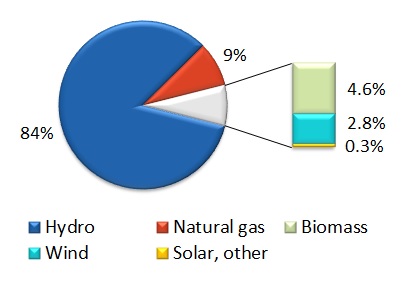
Text version of Pie Chart
Pie Chart of British Columbia’s installed electric capacity mix (2014): hydro 84%, natural gas 9%, biomass 4.6%, and others less than 3%
BC Hydro’s Site C Clean Energy Project, currently under construction, will provide 1,100 megawatts (MW) of capacity, and produce about 5,100 gigawatt hours (GWh) once complete.
Key organizations
The BC Utilities Commission is an independent regulatory agency of the Provincial Government. The Commission's primary responsibility is the regulation of British Columbia's natural gas and electricity utilities.
The Ministry of Energy and Mines is responsible for British Columbia’s electricity, alternative energy, mining and mineral exploration sectors. The Ministry is responsible for a number of Crown Corporations including British Columbia Hydro and Power Authority and Columbia Power Corporation.
British Columbia Hydro and Power Authority (BC Hydro) is the largest electricity utility in the province. In addition to generation, transmission and distribution of electricity for 1.9 million customers, BC Hydro is the provincial Balancing Authority and the largest Transmission Operator.
Electric reliability framework in British Columbia
British Columbia is part of the North American Bulk Electric System.
- The 2007 BC Energy Plan states that British Columbia will remain consistent with North American transmission reliability standards.
- In 2008, amendments to the Utilities Commission Act (UCA) created a mechanism for introducing mandatory reliability standards for British Columbia’s Bulk Electric System. Under the UCA, the BC Utilities Commission must adopt standards required to remain consistent with North American standards, unless the Commission considers those standards not to be in the public interest.
- The BC Utilities Commission’s mandatory reliability standards page provides further information and links related to standards adopted in British Columbia.
North American standards are those developed by either the North American Electric Reliability Corporation (NERC) or the Regional Entity for the Western Interconnection, the Western Electricity Coordinating Council (WECC).
For additional information related to how electric reliability standards are reviewed, adopted, monitored, and enforced in British Columbia, please go to the British Columbia Provincial Summary which is currently available on the NERC website: Provincial Summaries.
Alberta
| Installed Capacity | 16,130 MW |
| Annual Generation | 81,620 GWh |
| Annual Consumption | 82,400 GWh |
| Customers (major service areas only) | ~1.75 million |
| Annual Exports | 650 GWh |
| Annual Imports | 1,430 GWh |
| Transmission System length (≥ 69 kV) | ~ 25,295 km |
| Interconnections with British Columbia, Saskatchewan, Montana | |
Installed capacity mix (2015)Footnote 11
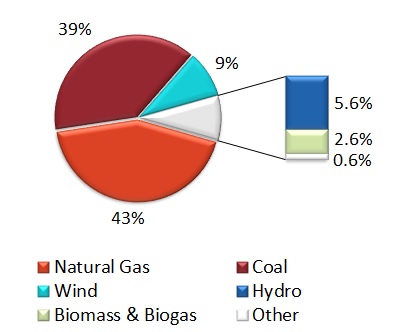
Text version of Pie Chart
Pie Chart of Alberta’s installed electric capacity mix (2015): natural gas 43%, coal 39%, wind 9%, hydro 6% and others less than 3%
Key organizations
Alberta Energy, a ministry of the Government of Alberta, has a strategic objective to provide a safe, reliable, and efficient electricity system that supports Albertans and aligns with the Government of Alberta’s Climate Leadership Plan priorities. The current competitive market structure is based on the four core policy tenets: open access transmission; energy-only market design; customer choice; and fair, efficient and openly competitive markets for electricity and ancillary services.
The Alberta Utilities Commission (AUC) is an independent, quasi-judicial agency of the province of Alberta. The AUC regulates the utilities sector, natural gas and electricity markets to protect social, economic and environmental interests where market forces do not. All Canadian provinces have some form of arm’s length regulation for their utilities, whether they are investor-owned as in Alberta or Crown corporations as in most other provinces.
The Alberta Electric System Operator (AESO) is the Independent System Operator for Alberta as defined in the Electric Utilities Act. The AESO is responsible for the long-term planning of the Alberta transmission system, operating Alberta’s energy-only market for electricity, and operating Alberta’s power grid on a 24/7 basis to ensure reliable power is available at all times to meet the needs of Albertans. The AESO also provides open and non-discriminatory access to Alberta's power grid for generation and distribution companies and large industrial consumers of electricity. The AESO is a not-for-profit entity that is independent of any industry affiliations and owns no transmission or market assets. Approximately 60 per cent of jurisdictions in North America have an Independent System Operator.
Alberta’s Market Surveillance Administrator (MSA) has a broad mandate including surveillance, investigation, and enforcement to help ensure the Fair, Efficient and Open Competition Regulation under the Alberta Utilities Commission Act and the Electric Utilities Act is followed. The MSA is unique to competitive investor-based jurisdictions and is needed to ensure that competition statutes are upheld by all electricity market participants.
Unique to Alberta, the Balancing Pool (BP) was established by the Government of Alberta in 1999 under the Electric Utilities Act, in order to help manage the transition to competition in Alberta’s electricity industry. It underwrites certain risks and obligations inherent in the Power Purchase Arrangements associated with previously regulated power plants.
Electric reliability framework in Alberta
Alberta is part of the North American Bulk Electric System through its interties with Saskatchewan, Montana and British Columbia. The North American Electric Reliability Corporation (NERC) develops reliability standards for the North American power industry that are reviewed in Alberta by the AESO for their applicability as Alberta Reliability Standards. The AESO then recommends approval or rejection of reliability standards to the Alberta Utilities Commission (AUC) and the AUC approves them unless they are technically deficient or not in the public interest. They may also be not applicable in the province (e.g. a nuclear standard). The MSA’s legislated mandate includes the enforcement of Alberta Reliability Standards.
The AESO is a member of the Western Electricity Coordinating Council (WECC), and the AESO participates in various WECC committees to coordinate with entities in the Western Interconnection.
For more information related to how electric reliability standards are reviewed, adopted, monitored, and enforced in Alberta, please go to the Alberta Provincial Summary which is currently available on the NERC website: Provincial Summaries.
Saskatchewan
| Installed Capacity* | 4,185 MW |
| Annual Generation | 22,627 GWh |
| Annual Consumption | 21,389 GWh |
| Customers | ~ 580,000 |
| Annual Exports | 90 GWh |
| Annual Imports | 797 GWh |
| Transmission System length (≥ 25 kV) | ~ 13,400 km |
| Interconnections with Alberta, Manitoba, North Dakota | |
Installed capacity mix (2015)Footnote 12
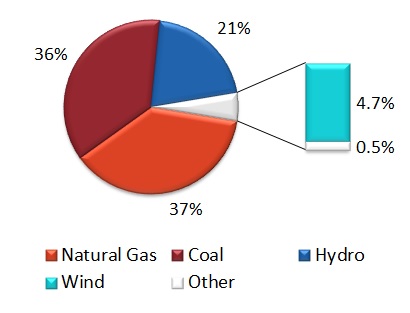
Text version of Pie Chart
Pie Chart of Saskatchewan’s installed electric capacity mix (2015): natural gas 37%, coal 36%, hydro 21%, wind 4.7%, and other less than 1%
*Three wind power projects, under development or approved, are expected to double SaskPower wind capacity by 2020. SaskPower has committed to doubling generation capacity from renewables (26%) by 2030
Generation from coal is subject to federal regulation on greenhouse gas emissions which requires either shutting down coal units when they reach a certain age or installing carbon capture and storage (CCS). In the past three years, SaskPower has converted one coal unit to CCS, the first commercial-scale project of its kind in the world, and shut down two other units.
Key organizations
The Government of Saskatchewan manages SaskPower through the Crown Investments Corporation. It approves rate changes and major investment decisions by SaskPower.
The Saskatchewan Rate Review Panel reviews rate proposals by SaskPower and provides opportunity for public questions and comments. It provides a report to the Government of Saskatchewan with recommendations on electricity rate changes.
Saskatchewan Power Corporation (SaskPower) is a Crown corporation, established by the Power Corporation Act, with exclusive franchise in Saskatchewan for transmission and distribution with exception of pre-existing municipal distribution franchises in the cities of Saskatoon and Swift Current. It provides all transmission services and the majority of distribution services and power generation in Saskatchewan. SaskPower is the system operator and provides reliability management. It is regulated by the Saskatchewan Rate Review Panel.
- NorthPoint Energy Solutions is a wholly owned subsidiary of SaskPower. It manages trading of electricity with other utilities and administers access to the SaskPower transmission system.
- Municipal Franchises of Saskatoon and Swift Current purchase bulk power from SaskPower and distribute it locally.
- Major independent power producers including Northland Power (346 MW), TransAlta (220 MW), ATCO (260 MW), Algonquin (26 MW), Suncor/Enbridge (11 MW), and NRGreen (20 MW) sell bulk power from gas, wind and waste heat to SaskPower under long-term power purchase agreements.
Electric reliability framework in Saskatchewan
Saskatchewan is part of the North American Bulk Electric System(BES) as a member of the Midwest ISO, and it meets North American Electric Reliability Corporation (NERC) standards. Saskatchewan has a Memorandum of Understanding (MOU) with NERC and the Midwest Reliability Organization (MRO) for audit and standard setting services and has been audited.
The SaskPower Board approved creation of the Saskatchewan Electric Reliability Authority (SERA) in 2010. SERA oversees regulatory compliance with NERC electric reliability standards in Saskatchewan.
For more detailed information related to how electric reliability standards are reviewed, adopted, monitored, and enforced in Saskatchewan, please go to the Saskatchewan Provincial Summary which is currently available on the NERC website: Provincial Summaries.
Manitoba
| Installed Capacity | 5,701 MW |
| Annual Generation | 36,040 GWh |
| Annual Consumption | 22,443 GWh |
| Customers | ~ 561,900 |
| Annual Exports | 9,878 GWh |
| Annual Imports | 216 GWh |
| Transmission System length (≥ 24 kV) | ~ 13,000 km |
| Interconnections with Ontario, Saskatchewan, North Dakota and Minnesota | |
Installed capacity mix (2015)Footnote 13
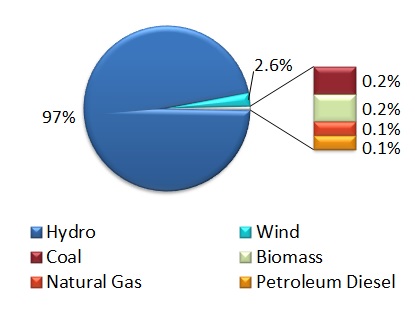
Text version of Pie Chart
Pie Chart showing Manitoba’s installed capacity mix (2015): hydro 97%, wind 2.6%, and others less than 0.3%
Over 99% of installed electric capacity in Manitoba is from non-emitting, renewable sources
Key organizations
The Energy Division in the Department of Growth Enterprise and Trade is responsible for developing broad provincial energy policy for both supply and demand side energy activities in Manitoba, and seek economic development opportunities related to energy development and energy efficiency activities.
Manitoba Hydro is the electric power and natural gas utility in the province of Manitoba. It is a provincial Crown Corporation, governed by the Manitoba Hydro-Electric Board and the Manitoba Hydro Act.
The Manitoba Public Utilities Board (PUB) is an independent board responsible for regulating the rates charged by Manitoba Hydro, as well as by other utilities such as Manitoba Public Insurance, gas and propane utilities, and all water and sewer utilities in Manitoba except for the City of Winnipeg.
Electric reliability framework in Manitoba
Manitoba is part of North American Bulk Electric System. Its high voltage system is connected to Ontario, Saskatchewan, and the Midwestern states.
On April 01, 2012 compliance to electricity reliability standards became a legal obligation in the Province by all users, owners and operators of its bulk power system. The electricity reliability standards presently in force in Manitoba are developed by the North American Electric Reliability Corporation (NERC) and adopted by the Province as specified in the Reliability Standards Regulation.
Manitoba Hydro and the two wind generation owner/operators (Pattern Energy Group Inc. and Algonquin Power and Utilities Corporation) are the only entities in Manitoba that must comply with the reliability standards.
The Midwest Reliability Organization (MRO) is the regional compliance enforcement authority for the three registered entities located in Manitoba. Monetary penalties and/or sanctions can be applied to violators of compliance requirements. Such penalties are determined in Manitoba by the Manitoba Public Utilities Board and enforced by a Board Order.
To view Manitoba’s Reliability Standards Regulation, visit the Manitoba Legislative Assembly website or click here.
For more detailed information related to how electric reliability standards are reviewed, adopted, monitored, and enforced in Manitoba, please go to the Manitoba Provincial Summary which is currently available on the NERC website: Provincial Summaries.
Ontario
| Installed Capacity | 35,591 MW |
| Annual Generation | 153.7 TWh |
| Annual Consumption | 137 TWh |
| Customers | ~ 4.9 million |
| Annual Exports | 22.6 TWh |
| Annual Imports | 5.8 TWh |
| Transmission System length (≥ 115 kV) | ~ 30,000 km |
| Interconnections with Quebec, Manitoba, New York, Michigan, Minnesota | |
Installed capacity mix (2015)Footnote 14
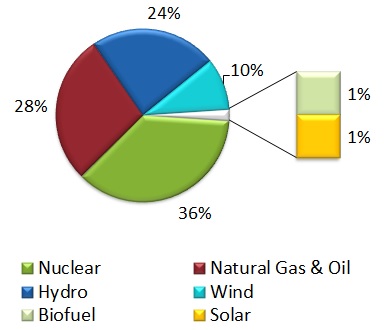
Text version of Pie Chart
Pie Chart showing Ontario’s installed capacity mix (2015): nuclear 36%, natural gas and oil 28%, hydro 24%, wind 10%, and others less than 2%
Approximately 90% of power generated in Ontario in 2015 came from clean sources of energy such as hydro, nuclear and renewables.
Ontario is the first jurisdiction in North America to eliminate coal as a source of electricity. Phasing out coal-fired electricity generation, completed in 2014, was the single largest climate change initiative in North America and the equivalent of taking up to 7 million cars off the road.
Key organizations
The Ontario Ministry of Energy (“Ministry”) is responsible for setting the policy and legislative framework for Ontario’s electricity system. The Ministry develops solutions and advises on all aspects of energy policy for Ontario, including electricity, natural gas and oil. It also has legislative responsibility for the Ontario Energy Board (“OEB”) and Independent Electricity System Operator (“IESO”).
The Independent Electricity System Operator (“IESO”) is a not-for-profit corporation in the Province of Ontario, Canada and established under the Electricity Act, 1998of Ontario. The objects of the IESO are described in s.6(1) of the Act and include statutory responsibility to develop and administer wholesale electricity markets, to direct the operation and maintain reliability of the IESO-controlled grid, to establish and enforce criteria and standards for reliability of the integrated power system made by standards authorities, to plan for adequacy and reliability of electricity resources, to administer and contract for electricity resources, and to promote electricity conservation within the Province of Ontario. The IESO is subject to the OEB’s oversight authority.
The Ontario Energy Board’s (OEB) mandate is determined by the provincial government and is embodied in legislation, regulation and directives. The OEB’s mission is to promote a viable, sustainable and efficient energy sector that serves the public interest and assists consumers to obtain reliable energy services that are cost effective. In the electricity sector, the OEB sets transmission and distribution rates, and approves the IESO’s budget and fees. The OEB also sets the rate for the Standard Supply Service for distribution utilities that supply electricity (commodity) directly to consumers. The OEB licenses all market participants including the IESO, generators, transmitters, electricity storage, distributors, wholesalers and retailers. OEB approval is required for the construction of electricity transmission lines longer than two kilometres.
Electric reliability regime in Ontario
Reliability standards are intended to ensure the integrity of the interconnected North American Bulk Electric System. The recognized standards authorities, the North American Electric Reliability Corporation (NERC) and the Northeast Power Coordinating Council (NPCC), define the reliability requirements for planning and operating the North American bulk electric system. NERC develops and enforces Reliability Standards and the Federal Energy Regulatory Commission (FERC) approves Reliability Standards. NPCC develops criteria that are applicable to NPCC entities.
Compliance with reliability standards and criteria has been mandatory and enforceable in Ontario through the Market Rules and OEB licences since 2002. IESO enforces NERC reliability standards and NPCC criteria through the Market Rules.
In 2006, NERC was certified as the Electric Reliability Organization (ERO) charged with developing and enforcing reliability standards in the U.S. Energy Policy Act (EPAct). NERC was also recognized as the international ERO in Ontario legislation and regulation.
The IESO has the authority under s. 32(1) (c) of the Electricity Act to establish standards and criteria relating to the reliability of electricity service or the IESO-controlled grid, if necessary.
The Ontario reliability standards framework was designed and is implemented according to the mutual understandings set out in Memoranda of Understanding between the IESO, NERC, and NPCC and between NERC and the OEB.
Generally, unless the OEB stays operation of a NERC reliability standard or remands back to NERC, a reliability standard becomes effective in Ontario when it is declared in force in the United States. The OEB or any person may make an application for review of a reliability standard as long as actions are initiated as prescribed in the s. 36.1 and s. 36.2 of the Electricity Act. If reviewed, the OEB has the authority to stop the standard from applying in Ontario and to refer it back to the standards authority.
The IESO is the sole Ontario entity accountable to NERC or NPCC for compliance with NERC reliability standards. This accountability includes violations by Ontario entities of any of these requirements. By extension of licence conditions, the OEB could also find licenced entities non-compliant and invoke penalties including revocation of licence and financial penalties for contravening enforceable provisions. The OEB remedies are independent of NERC or NPCC.
The Act also authorizes the IESO to make and enforce rules (“Market Rules”) that govern the operation of Ontario’s electricity system. The IESO’s compliance and enforcement activities have been delegated to an independent business unit called the Market Assessment and Compliance Division (MACD) through a letter of delegation from the IESO’s President and CEO to MACD’s Director. As such, MACD makes all determinations and exercises all authorities accorded the IESO in the Market Rules concerning monitoring, investigation and the enforcement of rules and standards concerning the wholesale electricity system and market.
For more information related to how standards are reviewed, adopted, monitored, and enforced in Ontario, please go to the Ontario Provincial Summary which is currently available on the NERC website: Provincial Summaries, and to the Reliability Standards Framework and Reliability Standards Compliance summaries on the IESO website.
Quebec
| Installed Capacity Footnote 15 | 41,556 MW |
| Annual Generation | 206 TWh (2014) |
| Annual Consumption | 171 TWh |
| Customers | ~ 4.2 million |
| Annual Exports | 23.5 TWh |
| Annual Imports | 0.27 TWh |
| Transmission System length (> 69 kV) | ~ 30,717 km |
| Interconnections with New England, New York, Ontario, New Brunswick, Newfoundland and Labrador | |
Installed capacity mix (2015)Footnote 16
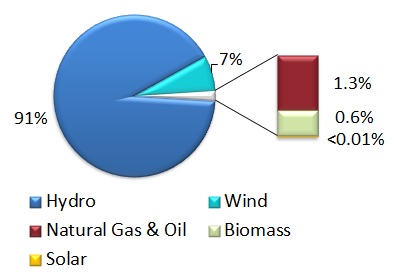
Text version of Pie Chart
Pie Chart showing Quebec’s installed capacity mix (2015): hydro 91%, wind 7%, and others less than 2%
The vast majority of electricity generated in Quebec is from renewable sources.
Hydro-Quebec, the Province’s largest supplier, generates more than 99% of its electricity from water.
Key organizations
The ministère de l’Énergie et des Ressources naturelles (the “Ministry”) is responsible for, among other things, setting the policy and legislative framework for Québec’s electricity system. The Ministry develops solutions and advises on all aspects of energy policy for Québec, including electricity, natural gas and oil.
The Régie de l’énergie (the “Régie”) is an independent, economic regulation agency that regulates the province’s electricity and natural gas sectors in the public interest. Pursuant to its governing legislation, the Act respecting the Régie de l’énergie (the “Act”), it has the authority to establish, monitor and enforce a mandatory regime of reliability standards for electricity transmission in Québec.
Hydro-Québec generates, transmits and distributes electricity. Its sole shareholder is the Québec government.
Electric reliability framework in Quebec
Quebec is part of the North American Bulk Electric System, with significant interconnections to the United States and neighbouring provinces. Quebec recognizes the North American Electricity Reliability Corporation (NERC) and the Northeast Power Coordinating Council (NPCC) as experts in the development and monitoring of electric power transmission reliability standards. The 2014 Agreement on the Implementation of the Québec Reliability Standards Compliance Monitoring and Enforcement Program, among the Regie, NERC and NPCC, sets out the mandate that the Regie has granted NERC and the NPCC for the implementation of Quebec’s Reliability Standards Compliance Monitoring and Enforcement Program. The Program defines the framework used by NPCC to provide opinions, observations and recommendations to the Régie regarding the enforcement of the Reliability Standards within Québec, mitigation plans and remedial actions, where applicable.
Hydro-Québec TransÉnergie operates the Quebec transmission system, markets system capacity and manages power flows across Québec. Within TransEnergie, the Contrôle des mouvements d'énergie is designated by the Regie as the Reliability Coordinator, responsible to oversee the reliable operation of Quebec’s electricity grid.
For more information related to how electric reliability standards are reviewed, adopted, monitored, and enforced in Quebec, please go to the Quebec Provincial Summary which is currently available on the NERC website: Provincial Summaries.
New Brunswick
| Installed Capacity | 4,251 MW |
| Annual Generation | 14,393 GWh |
| Annual Consumption | 13,648 GWh |
| Customers | ~ 398,000 |
| Annual Exports | 2,517 GWh |
| Annual Imports | 2,537 GWh |
| Transmission System length (≥ 69 kV) | ~ 6,849 km |
| Interconnections with Quebec, Nova Scotia, Prince Edward Island, New England, Northern Maine | |
Installed capacity mix (2014)Footnote 17
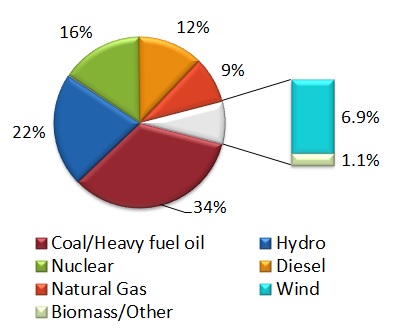
Text version of Pie Chart
Pie Chart showing New Brunswick’s installed capacity mix (2014): coal/heavy oil 34%, hydro 22%, nuclear 16%, diesel 12%, natural gas 9%, wind 6.9%, and other less than 2%
Key organizations
New Brunswick Department of Energy and Mines is responsible for setting the policy and legislative framework for New Brunswick’s electricity system. The Department administers the Electricity Act and Reliability Standards Regulation which establishes the authority and requirements for the adoption and enforcement of electric reliability standards in New Brunswick.
The New Brunswick Energy and Utilities Board (EUB) is a crown agency established to regulate the electricity, natural gas, pipeline, motor carrier industries, and set maximum gasoline prices for the province.
The New Brunswick Power Corporation (NB Power) is a Crown corporation and the province’s vertically integrated electric utility. In addition to its responsibility to comply with reliability standards applicable to its functions, NB Power is also responsible under the Electricity Act to make filings to the EUB to update reliability standards, maintain a list of bulk power system elements and to make recommendations on compliance registrations. In addition to NB Power, there are three municipal distribution utilities:
The New Brunswick Energy Marketing Corporation is the Crown corporation responsible for the purchase and sale of power across with neighbouring jurisdictions.
Electric reliability framework in New Brunswick
New Brunswick is connected to the North American Bulk Electric System (BES) through interconnections in New England, as well as HVDC connections with Quebec. Electric reliability is maintained through Reliability Standards adoption, compliance monitoring, and enforcement by the New Brunswick Energy and Utilities Board (EUB).
Compliance with bulk power system reliability standards is mandatory in NB under the Electricity Act. The New Brunswick Energy and Utilities Board (EUB) is responsible under the Act to adopt and enforce reliability standards and to implement the Reliability Standards Regulation, which sets out specific requirements for the adoption of reliability standards, compliance registry and compliance monitoring and enforcement processes.
The EUB establishes and maintains a NB Compliance Registry that identifies those owners, operators and users of the NB bulk power system that must comply with adopted reliability standards. Criteria used to determine a registration in NB is generally based on the North American Electric Reliability Corporation (NERC) registration criteria. An entity that has been notified of its requirement to register may appeal to the EUB for further consideration. The NB Compliance Registry is posted on the EUB website.
The EUB implements a compliance monitoring program to assess registered entity compliance with adopted standards. Monitoring methods include entity self-certification, self-reporting, data submittals, audits, investigations, spot checks and complaints. The Compliance Monitoring and Reporting System (CMRS) is used to facilitate electronic reporting by entities.
A NB Annual Implementation Plan for compliance monitoring is developed and posted by the EUB each year prior to January 1 of the reporting year. The NB Annual Implementation Plan identifies the reliability standards that will be monitored, the monitoring method to be used, and entity audit and reporting schedules.
As provided for in the Electricity Act, the EUB engages the Northeast Power Coordinating Council (NPCC) as a recognized compliance body to assist with the implementation of the compliance monitoring program in NB.
The EUB initiates enforcement action if there is reason to believe that a violation of a reliability standard has occurred. EUB enforcement requires that the entity take action to remove the risk the violation poses to the reliability of the bulk power system and to implement a plan that will prevent a future occurrence of the violation. Registered entities are subject to financial penalties and sanctions for violations of adopted reliability standards.
For additional information related to how electric reliability standards are reviewed, adopted, monitored, and enforced in New Brunswick, please go to the New Brunswick Provincial Summary which is currently available on the NERC website: Provincial Summaries.
Nova Scotia
| Installed Capacity* | 2,979 MW |
| Annual Generation | 11,129 GWh |
| Annual Consumption | 10,412 GWh |
| Customers | ~ 506,000 |
| Annual Exports | 31 GWh |
| Annual Imports | 428 GWh |
| Transmission System length (≥ 69 kV) | ~ 5,300 km |
| Interconnections with New Brunswick | |
Installed capacity mix (2015)Footnote 18
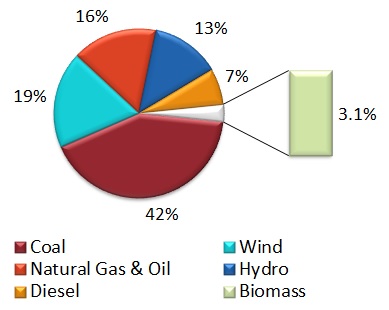
Text version of Pie Chart
Pie Chart showing Nova Scotia’s installed capacity mix (2015): coal 42%, wind 19%, natural gas and oil 16%, hydro 13%, diesel 7% and others less than 4%
*496 MW of Nova Scotia’s installed capacity are from independently owned renewables.
Nova Scotia successfully met its renewable energy target for 2015 (25%) and is on track for its 2020 target (40%). A planned new interconnection to Newfoundland and Labrador, as of 2018, is expected to provide > 1,000 GWh in imports.
Key organizations
Nova Scotia Power Incorporated (NSPower) is an investor owned utility; it is vertically integrated and responsible for the large majority of NS’s distribution and generation as well as all of the transmission.
The Nova Scotia Utility and Review Board (UARB) is an independent tribunal that regulates utilities, including NSPower, to ensure operation within the bounds of the law.
The Government of Nova Scotia provides the legal framework that the utility operates within.
Electric reliability framework in Nova Scotia
Nova Scotia is part of the North American Bulk Electric System (BES), its high-voltage transmission grid is connected to New Brunswick. The BES is a highly integrated electricity transmission network involving hundreds of thousands of kilometers of high-voltage transmission lines across Canadian, American, and Mexican jurisdictions.
Since 2004, Canadian and American authorities have worked collaboratively to implement a harmonized approach to mandatory Reliability Standards for the BES. These standards are developed by an Electric Reliability Organization (ERO) composed of the North American Electric Reliability Corporation (NERC) and its eight Regional Entities (REs).
Nova Scotia recognizes NERC as an electric reliability standards-setting organization and is part of the Northeast Power Coordinating Council (NPCC) Regional Entity.
For more detailed information related to how electric reliability standards are reviewed, adopted, monitored, and enforced in Nova Scotia, please go to the Nova Scotia Provincial Summary which is currently available on the NERC website: Provincial Summaries.
Prince Edward Island
| Installed Capacity | 365 MW |
| Annual Generation | 635 GWh |
| Annual Consumption | 1,332 GWh |
| Customers | ~ 77,000 |
| Annual Exports | 280 GWh |
| Annual Imports | 1,068 GWh |
| Transmission System length (≥ 69 kV) | ~ 700 km |
| Interconnection with New Brunswick | |
Installed capacity mix (2015)Footnote 19
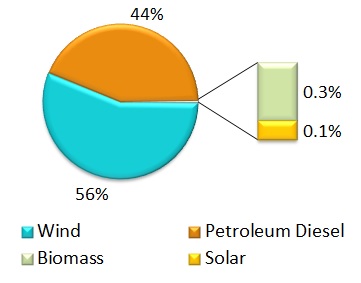
Text version of Pie Chart
Pie Chart showing Prince Edward Island’s installed capacity mix (2015): wind 56%, petroleum diesel 44%, and others less than 1%
The Prince Edward Island electricity grid is connected to New Brunswick by two submarine cables.
Key organizations
The Island Regulatory and Appeals Commission (IRAC) is an independent quasi-judicial tribunal operating under the authority of the Island Regulatory and Appeals Commission Act. The Commission administers a number of provincial statutes dealing with economic regulation and hears appeals under provincial planning, tax and residential rental property legislation.
The Commission operates at arms-length from the Provincial Government. It has three full-time and up to five part-time Commissioners and a staff complement of 19. The Commission reports to the Legislative Assembly of Prince Edward Island through the Minister of Education, Early Learning and Culture. The Electric Power Act gives IRAC the authority to regulate the electricity sector in the province.
The PEI Energy Corporation (a Crown corporation) is responsible for pursuing and promoting the development of energy systems and the generation, production, transmission and distribution of energy, in all its forms, on an economic and efficient basis. The PEI Energy Corporation owns and operates over 70 MW of commercial-grade wind turbines located in the eastern and western portions of PEI. The PEI Energy Corporation and the Energy and Minerals Division of the Department of Transportation, Infrastructure and Energy jointly coordinate the development and implementation of electricity policy in the province.
Maritime Electric Company Ltd. is an indirect wholly-owned subsidiary of Fortis Inc. and operates under the provisions of the Electric Power Act and the Renewable Energy Act. Maritime Electric owns and operates a fully integrated system providing for the generation, transmission and distribution of electricity to customers throughout Prince Edward Island with the exception of the area served by the City of Summerside Electric Utility.
The City of Summerside Electric Utility operates under the Department of Municipal Services of the City of Summerside. The utility owns and operates 15 MW of diesel generation and 12MW of wind generation. The Summerside operations are about 10% of the total Island-wide electricity system.
Electric reliability framework in Prince Edward Island
Prince Edward Island is connected to the North American Bulk Electric System through its interconnection with New Brunswick. PEI’s high voltage transmission consists of generally short 69 kV and 138 kV lines, and only a small number of these would qualify as BES elements as defined by the North American Electric Reliability Corporation (NERC). PEI is not a member of the Northeast Power Coordination Council (NPCC), one of eight regional entities that work with NERC; however PEI generally follows the reliability criteria as set out for NPCC members. PEI’s main electric utility collaborates with other Maritimes utilities to ensure that PEI provides appropriate reliability and support to the neighbouring jurisdictions.
Newfoundland & Labrador
| Installed Capacity Footnote 20 | 7,644 MW |
| Annual GenerationFootnote 21 | 42,220 GWh |
| Annual Consumption | 11,240 GWh |
| Customers | ~ 300,150 |
| Annual Exports | ~ 30,293 GWh |
| Annual Imports | 24.6 GWh |
| Transmission System length Footnote 22 (≥ 66 kV) | 5,800 km + 700 km |
| Interconnections with Quebec | |
Installed capacity mix (2016)Footnote 23
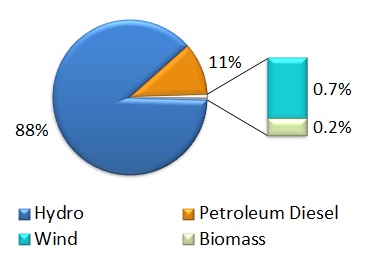
Text version of Pie Chart
Pie Chart showing Newfoundland and Labrador’s installed capacity mix (2016): hydro 88%, petroleum diesel 11%, and others less than 1%
Key organizations
The Newfoundland and Labrador Department of Natural Resources is responsible for the stewardship and development of the province's natural resources. The Department’s Energy Branch has responsibility for legislative, regulatory and policy functions related to the oil and gas and electric utility sectors.
The Board of Commissioners of Public Utilities (PUB) is an independent, quasi-judicial regulatory body appointed by the Lieutenant- Governor in Council. The PUB operates primarily under the authority of the Public Utilities Act, R.S.N. 1990. The PUB is the regulator of Newfoundland and Labrador’s electric utilities and is responsible for ensuring that the electricity rates charged to consumers are just and reasonable, and the electrical service provided is safe and reliable.
Newfoundland and Labrador Hydro (NLH) is a wholly-owned subsidiary of crown corporation Nalcor Energy, which is the Province’s energy corporation. NLH generates and delivers electricity to utility, industrial, residential and commercial customers in over 200 communities in the province. The corporation’s primary customer groups are: NP, industrial customers; and residential and commercial customers in rural Newfoundland and Labrador.
Newfoundland Power (NP) is an investor-owned subsidiary of Fortis Inc. and operates an integrated generation, transmission and distribution system throughout the island portion of Newfoundland and Labrador. The company services 87% of all electricity consumers in the province. The company operates 23 hydro plants, two diesel plants, three gas turbine facilities, 130 substations and approximately 11,000 km of transmission and distribution lines.
Electric reliability framework in Newfoundland and Labrador
Newfoundland and Labrador’s bulk electric system presently includes the Island Interconnected System, which is isolated from the rest of North America, and the Labrador Interconnected System which shares an interconnection with Quebec. The two systems are currently isolated from one another. Upon completion of the HVDC Labrador Island Link and the Maritime Link which are currently under construction, the two systems will be interconnected and the Island of Newfoundland will be interconnected to the North American Bulk Electric System.
Provincial reliability is presently governed by voluntarily-adopted electric reliability practices developed by NLH and NP based on standard industry practices with review oversight exercised by the PUB. As part of ensuring electric reliability, the PUB is responsible for reviewing and approving the utilities’ annual capital budgets.
Upon completion of the Maritime Link and the Muskrat Falls Project, which includes the Muskrat Falls Generating Facility, the Labrador Island Link, and the Labrador Transmission Assets, the Island portion of the province will be interconnected for the first time with the North American bulk electric system via Labrador and Nova Scotia. Interconnection will enable exports and imports to achieve greater value from provincial electrical generation and enable improved electric system reliability.
Newfoundland and Labrador is presently contemplating ways to ensure the appropriate reliability standards are in place following interconnection, and assessing the implications of North American Electric Reliability Corporation (NERC) and Northeast Power Coordinating Council (NPCC) membership and standards implementation as well as any reliability oversight roles that may change following interconnection.